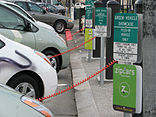Charging station: Difference between revisions
→E-Move charging station: rem toy sections |
|||
| Line 298: | Line 298: | ||
Charging stations are typically connected to the grid, which in most jurisdictions relies on [[fossil-fuel power station]]s. However, [[renewable energy]] may be used to reduce the use of grid energy.<!-- per sources, it appears if it is mostly just a marketing gimmick to show "solar", but most power is from the electrical grid. Can we get sources of any fully-solar charging stations? Do they exist? --> Nidec Industrial Solutions has a system that can be powered by either the grid or renewable energy sources like PV.{{cn|date=March 2021}} In 2009, [[SolarCity]] marketed its solar energy systems for charging installations. The company announced a single demonstration station in partnership with [[Rabobank]] on [[U.S. Route 101|Highway 101]] between San Francisco and Los Angeles.<ref name=gtm20090922>{{cite web|url= http://www.greentechmedia.com/articles/read/solarcity-installs-electric-car-chargers-along-cal-highway/ |title=SolarCity Installs Electric Car Chargers Along Cal Highway|date=22 September 2009 |access-date=16 July 2015 }}</ref> |
Charging stations are typically connected to the grid, which in most jurisdictions relies on [[fossil-fuel power station]]s. However, [[renewable energy]] may be used to reduce the use of grid energy.<!-- per sources, it appears if it is mostly just a marketing gimmick to show "solar", but most power is from the electrical grid. Can we get sources of any fully-solar charging stations? Do they exist? --> Nidec Industrial Solutions has a system that can be powered by either the grid or renewable energy sources like PV.{{cn|date=March 2021}} In 2009, [[SolarCity]] marketed its solar energy systems for charging installations. The company announced a single demonstration station in partnership with [[Rabobank]] on [[U.S. Route 101|Highway 101]] between San Francisco and Los Angeles.<ref name=gtm20090922>{{cite web|url= http://www.greentechmedia.com/articles/read/solarcity-installs-electric-car-chargers-along-cal-highway/ |title=SolarCity Installs Electric Car Chargers Along Cal Highway|date=22 September 2009 |access-date=16 July 2015 }}</ref> |
||
[[File:Phillips Chevrolet's Solar Charging Station for Electric Vehicles.JPG|thumb|center|750px|Several [[Chevrolet Volt]]s at a charging station partially powered with [[solar panel]]s in [[Frankfort, Illinois]].]] |
[[File:Phillips Chevrolet's Solar Charging Station for Electric Vehicles.JPG|thumb|center|750px|Several [[Chevrolet Volt]]s at a charging station partially powered with [[solar panel]]s in [[Frankfort, Illinois]].]]The E-Move Charging Station is equipped with eight monocrystalline solar panels, which can supply 1.76 kWp of solar power.<ref>{{cite web|url= http://www.ecofriend.org/entry/eco-tech-e-move-charging-station-fuels-just-about-everything-with-solar-energy/ |title=Archived copy |access-date=2012-04-07 |url-status=dead |archive-url= https://web.archive.org/web/20131130021746/http://www.ecofriend.org/entry/eco-tech-e-move-charging-station-fuels-just-about-everything-with-solar-energy/ |archive-date=2013-11-30 }}</ref> |
||
====E-Move charging station==== |
|||
The E-Move Charging Station is equipped with eight monocrystalline solar panels, which can supply 1.76 kWp of solar power.<ref>{{cite web|url= http://www.ecofriend.org/entry/eco-tech-e-move-charging-station-fuels-just-about-everything-with-solar-energy/ |title=Archived copy |access-date=2012-04-07 |url-status=dead |archive-url= https://web.archive.org/web/20131130021746/http://www.ecofriend.org/entry/eco-tech-e-move-charging-station-fuels-just-about-everything-with-solar-energy/ |archive-date=2013-11-30 }}</ref> |
|||
====Wind-powered charging station==== |
|||
In 2012, [[Urban Green Energy]] introduced the world's first wind-powered electric vehicle charging station, the Sanya SkyPump. The design features a 4 kW vertical-axis wind turbine paired with a GE WattStation.<ref>{{cite web|url= http://www.digitaltrends.com/cars/sanya-skypump-worlds-first-wind-powered-ev-charging-station-debuts-in-spain/ |title=Sanya Skypump: World's first wind-fueled EV charging station – Digital Trends|date=14 August 2012|work=Digital Trends|access-date=16 July 2015}}</ref> |
In 2012, [[Urban Green Energy]] introduced the world's first wind-powered electric vehicle charging station, the Sanya SkyPump. The design features a 4 kW vertical-axis wind turbine paired with a GE WattStation.<ref>{{cite web|url= http://www.digitaltrends.com/cars/sanya-skypump-worlds-first-wind-powered-ev-charging-station-debuts-in-spain/ |title=Sanya Skypump: World's first wind-fueled EV charging station – Digital Trends|date=14 August 2012|work=Digital Trends|access-date=16 July 2015}}</ref> |
||
{{clear}} |
{{clear}} |
||
Revision as of 20:14, 27 March 2021
| ||||
Charging stations for electric vehicles:
|
A charging station, also called electric vehicle charging station, electric recharging point, charging point, charge point, electronic charging station (ECS), and electric vehicle supply equipment (EVSE), is a machine that supplies electric energy to charge plug-in electric vehicles—including cars, neighborhood electric vehicles, trucks, buses and others.
Some electric vehicles have on-board converters that plug into a standard electrical outlet or a higher voltage outlet. Others use custom charging stations.
Charging stations provide connectors that conform to a variety of standards. For common direct current rapid charging, chargers are equipped with multiple adaptors such as Combined Charging System (CCS), CHAdeMO, and AC fast charging.
Public charging stations are typically found street-side or at retail shopping centers, government facilities and parking areas.
Sites
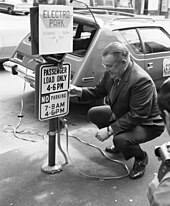

Charging stations are found in several locations:
- Residences: Charging can be via a standard receptacle (such as NEMA connector in the US) or a higher voltage outlet.[2] A home charging station typically lacks user authentication and separate metering, but may require a dedicated circuit.[3] Some portable chargers can be wall mounted.
- Public: a private or commercial venture charges vehicles for a fee or free. Charge rates vary from residential speeds up to many times higher. Vehicles can be charged without the owner present, allowing the owner to partake of other activities.[4] Sites include malls, freeway rest stops, transit stations, government offices, etc.[5][6] Typically, AC Type1 / Type2 plugs are used. Fast charging rates begin at >40 kW and range up to 250 kW.
- Mobile: another vehicle brings the charger to the vehicle.
- Wireless: Inductive charging mats allow charging without a wired connection and can be embedded in parking stalls or even on roadways.
Common connectors include J1772, Type 2 connector Type 3 connector, Combined charging system, CHAdeMO, and Tesla Superchargers.[7]
A specified target for California Air Resource Board credits for a zero-emission vehicle is adding 200-mile (300 km) to its range in under 15 minutes. The intent was to match the refueling expectations of internal combustion engine drivers.
Charging time
This section needs additional citations for verification. (March 2021) |

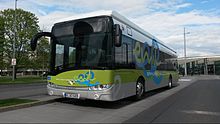
Charging time basically depends on the battery's capacity, power density and charging power. The larger the capacity, the more charge the battery can hold (analogous to the size of the fuel tank). Higher power density allows the battery to accept more charge/unit time (the size of the tank opening).Greater charging power supplies more power/unit time (the pump's flow rate).
Charge time can be calculated as:
Charging Time [h] = Battery Capacity [kWh] / Effective Charging Power [kW].[8]
The effective charging power can be lower than the maximum charging power due to limitations of the battery or battery management system, charging losses (which can be as high as 25%[9]), and vary over time due to charging limits applied by a or a charge controller.
Battery capacity
The usable battery capacity of a first-generation electric vehicle, such as the original Nissan Leaf, is about 20 kWh, giving it a range of about 100 mi (160 km). Tesla was the first company to introduce longer-range vehicles, initially releasing their Model S with battery capacities of 40 kWh, 60 kWh and 85 kWh, with the latter lasting for about 480 km (300 mi). Plug-in hybrid vehicles typically have capacity of roughly 3 to 20 kWh, lasting for 20 to 80 kilometers (15 to 50 miles).
AC/DC
In the US, charging can be done directly from the AC-powered grid or have the external charger convert the AC to DC and supply the result to the car. The latter solution provides much faster charge times.
| Power supply | Power | Voltage | Max. current | Charging time |
|---|---|---|---|---|
| Single phase | 3.3 kW | 230 V AC | 16 A | 5–6 hours |
| Single phase | 7.4 kW | 230 V AC | 32 A | 2-2½ hours |
| Three phase | 11 kW | 400 V AC | 16 A | 1½-2 hours |
| Three phase | 22 kW | 400 V AC | 32 A | 44–55 minutes |
| Three phase | 43 kW | 400 V AC | 63 A | 22–28 minutes |
| Direct current (DCFC) | 50 kW | 400–500 V DC | 100–125 A | 19–24 minutes |
| Direct current (DCFC) | 120 kW | 300–500 V DC | 300–350 A | 8–10 minutes |
Costs
Costs vary greatly by country, power supplier and power source. Some services charge by the minute, while others charge by the amount of power received (kWh).
United States
In 2017, Tesla gave the owners of its Model S and Model X cars 400 kWh of Supercharger credit,[10] although this varied over time. The price ranges from $0.06 to $0.26 per kWh in the United States.[11] Tesla superchargers are usable only by Tesla vehicles.
Other charging networks are available for all electric vehicles. The Blink network has both Level 2 and DC Fast Chargers and charges separate rates for members and non members. Their prices range from $0.39 to $0.69 per kWh for members and $0.49 to $0.79 per kWh for non-members, depending on location.[12] The ChargePoint network has free chargers and paid chargers that drivers activate with a free membership card.[13] Prices are based on local rates. Other networks may accept cash or a credit card.
Safety


Charging stations are usually accessible to multiple electric vehicles and are equipped with current or connection sensing mechanisms to disconnect the power when the EV is not charging.
The two main types of safety sensor:
- Current sensors monitor power consumed, and maintain the connection only while demand is within a predetermined range.[citation needed]
- Sensor wires provide a feedback signal such as specified by the SAE J1772 and IEC 62196 schemes that require special (multi-pin) power plug fittings.
Sensor wires react more quickly, have fewer parts to fail, and are possibly less expensive to design and implement.[citation needed] Current sensors however can use standard connectors and can allow suppliers to monitor or charge for the electricity actually consumed.
SAE charging levels
North America
The Society of Automotive Engineers (SAE International) defines the general physical, electrical, communication and performance requirements for EV charging systems used in North America, as part of standard SAE J1772.[14]
The International Electrotechnical Commission (IEC) has adopted a majority of the SAE J1772 standard under IEC 62196-1 for international implementation.
Charging "Levels" are based upon the power distribution type, standards and maximum power.
Alternating Current (AC)
AC charging stations connect the vehicle's onboard charging circuitry directly to the AC Supply.[14]
- AC Level 1: Connects directly to a standard 120 V North American residential outlet; capable of supplying 12-16 A (1.4-1.92 kW) depending on the capacity of a dedicated circuit.
- AC Level 2: Utilizes 240 V residential or 208 V commercial power to supply between 6 and 80 A (1.4-19.2 kW). It provides a significant charging speed increase over Level 1 charging.
Direct Current (DC)
Commonly incorrectly called Level 3 Charging, DC fast charging is categorized separately. In DC fast charging, grid power is passed through an AC/DC Inverter before reaching the vehicle's battery, bypassing the onboard charging circuitry.[14]
- DC Level 1: Supplies a maximum of 80 kW at 50-1000 V.
- DC Level 2: Supplies a maximum of 400 kW at 50-1000 V.
For electric cars and light trucks, an extension to the CCS DCFC standard is under development for larger commercial vehicles. It was to be called High Power Charging for Commercial Vehicles (HPCCV). HPCCV is expected to operate in the range of 200-1500 V and 0-3000 A for a theoretical maximum power of 4.5 MW. The proposal calls for HPCCV charge ports to be compatible with existing CCS and HPC chargers.[15]
Public charging stations





Longer drives require a network of public charging stations. In addition, they are essential for vehicles that lack access to a home charging station, as is common in multi-family housing.
Charging stations may not need much new infrastructure in developed countries, less than delivering a new fuel over a new network.[16] The stations can leverage the existing ubiquitous electrical grid.[17]
Charging stations are offered by public authorities, commercial enterprises and some major employers to address range barriers. Options include simple charging posts for roadside use, charging cabinets for covered parking places and fully automated charging stations integrated with power distribution equipment.[18]
As of December 2012[update], around 50,000 non-residential charging points were deployed in the U.S., Europe, Japan and China.[19] As of August 2014[update], some 3,869 CHAdeMO quick chargers were deployed, with 1,978 in Japan, 1,181 in Europe and 686 in the United States, and 24 in other countries.[20]
Asia/Pacific
As of December 2012[update], Japan had 1,381 public quick-charge stations, the largest deployment of fast chargers in the world, but only around 300 slow chargers.[19] As of December 2012[update], China had around 800 public slow charging points, and no fast charging stations.[19]
As of September 2013[update], the largest public charging networks in Australia were in the capital cities of Perth and Melbourne, with around 30 stations (7 kW AC) established in both cities – smaller networks exist in other capital cities.[21]
Europe
As of December 2013[update], Estonia was the only country that had completed the deployment of an EV charging network with nationwide coverage, with 165 fast chargers available along highways at a maximum distance of between 40 to 60 km (25 to 37 mi), and a higher density in urban areas.[22][23][24]
As of November 2012[update], about 15,000 charging stations had been installed in Europe.[25]
As of March 2013[update], Norway had 4,029 charging points and 127 quick charging stations.[26] As part of its commitment to environmental sustainability, the Dutch government initiated a plan to establish over 200 fast (DC) charging stations across the country by 2015. The rollout will be undertaken by ABB and Dutch startup Fastned, aiming to provide at least one station every 50 kilometres (31 miles) for the Netherlands' 16 million residents.[27] In addition to that, the E-laad foundation installed about 3000 public (slow) charge points since 2009.[28]
North America
As of August 2018[update], 800,000 electric vehicles and 18,000 charging stations operated in the United States,[29] up from 5,678 public charging stations and 16,256 public charging points in 2013.[30][31] By July 2020, Tesla had installed 1,971 stations (17,467 plugs).[32]
As of August 2019, in the U.S., there are 2,140 CHAdeMO charge stations (3,010 plugs), 1,888 SAE CCS1 charge stations (3,525 plugs), and 678 Tesla super charger stations (6,340 plugs), according to the U.S. DoE's Alternative Fuels Data Center.[33]
Colder areas such as Finland, some northern US states and Canada have some infrastructure for public power outlets provided primarily for use by block heaters. Although their circuit breakers prevent large current draws for other uses, they can be used to recharge electric vehicles, albeit slowly.[34] In public lots, some such outlets are turned on only when the temperature falls below −20 °C, further limiting their value.[35]
South America
In April 2017, YPF, the state-owned oil company of Argentina, reported that it will install 220 fast-load stations for electric vehicles in 110 of its service stations in national territory.[36]
Sites
Charging stations can be sited wherever electric power and adequate parking are available. As of 2017[update], charging stations had been criticized for as inaccessible, hard to find, out of order, and slow; thus slowing EV adoption.[37] As of 2018 a few gas stations offered EV charging stations.[38] As of 2021, in addition to home stations, public stations had been sited along highways, in shopping centers, hotels, government facilities and at workplaces.
Projects
Electric car manufacturers, charging infrastructure providers, and regional governments have entered into agreements and ventures to promote and provide electric vehicle networks of public charging stations.
The EV Plug Alliance[39] is an association of 21 European manufacturers that proposed an IEC norm and a European standard for sockets and plugs. Members (Schneider Electric, Legrand, Scame, Nexans, etc.) claimed that the system was safer because they use shutters. Prior consensus was that the IEC 62196 and IEC 61851-1 standards have already established safety by making parts non-live when touchable.[40][41][42]
Battery swap
A battery swapping (or switching) station allow vehicles to exchange a discharged battery pack for a charged one, eliminating the charge interval. Battery swapping is common in electric forklift applications.[43]
History
The concept of an exchangeable battery service was proposed as early as 1896. It was first offered between 1910 and 1924, by Hartford Electric Light Company, through the GeVeCo battery service, serving electric trucks. The vehicle owner purchased the vehicle, without a battery, from General Vehicle Company (GeVeCo), part-owned by General Electric.[44] The power was purchased from Hartford Electric in the form of an exchangeable battery. Both vehicles and batteries were designed to facilitate a fast exchange. The owner paid a variable per-mile charge and a monthly service fee to cover truck maintenance and storage. These vehicles covered more than 6 million miles.
Beginning in 1917, a similar service operated in Chicago for owners of Milburn Electric cars.[45] A rapid battery replacement system was implemented to service 50 electric buses at the 2008 Summer Olympics.[46]

In 1993[47] Suntera developed a two-seat 3-wheel electric vehicle called the SUNRAY, which came with a battery cartridge that swapped out in minutes at a battery-swap station located. In 1995, added a motor scooter.[48] The company was later renamed Personal Electric Transports[49](P.E.T.). After 2000 the company developed an electric bus. In 2004, the company's 3-wheel stand-up EV won 1st place at the 5-day long American Tour De Sol electric vehicle race,[50] before closing in 2006.
Better Place, Tesla, and Mitsubishi Heavy Industries considered battery switch approaches.[51][52] One complicating factor was that the approach requires vehicle design modifications.
In 2013, Tesla announced a proprietary charging station service. A network of Tesla Supercharger stations was envisioned to support both battery pack swaps and fast charging.[53][54] Tesla later focused exclusively on fast-charging stations.[55]
Benefits
The following benefits are claimed for battery swapping:
- "Refueling" in under five minutes.[56][57]
- Automation: The driver can stay in the car while the battery is swapped.[58]
- The driver does not own any batteries, transferring cost and management overhead to the station company.[59]
- Switch company subsidies could reduce prices without involving vehicle owners.[60]
- Spare batteries could participate in vehicle to grid energy services.[citation needed]
Providers
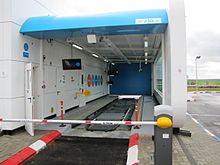
The Better Place network was the first modern attempt at the battery switching model. The Renault Fluence Z.E. was the first car enabled to adopt the approach and was offered in Israel and Denmark.[61]
Better Place launched its first battery-swapping station in Israel, in Kiryat Ekron, near Rehovot in March 2011. The exchange process took five minutes.[56][62] Better Place filed for bankruptcy in Israel in May 2013.[63][64]
In June 2013, Tesla announced its plan to offer battery swapping. Tesla showed that a battery swap with the Model S took just over 90 seconds.[57][65] Elon Musk said the service would be offered at around US$60 to US$80 at June 2013 prices. The vehicle purchase included one battery pack. After a swap, the owner could later return and receive their battery pack fully charged. A second option would be to keep the swapped battery and receive/pay the difference in value between the original and the replacement. Pricing was not announced.[57] In 2015 the company abandoned the idea for lack of customer interest.[66]

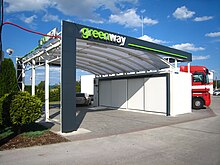
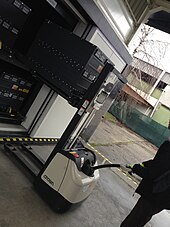
Other battery swapping service providers include Gogoro, Delta Electronics, BattSwap,[citation needed] and Voltia.[67][68] NIO has 131 swap stations in China.[69]
Criticism
Battery swapping solutions were criticized as proprietary. By creating a monopoly regarding the ownership of the batteries and the patent protected technologies the companies split up the market and decrease the chances of a wider usage of battery swapping.[70]
Standards
Voltage and power
The US-based SAE International defines various charging levels.
AC Level 1 charging uses a 120 volt AC outlet.[71] Level 1 is not used in countries where houses have 200-240 V.
AC Level 2 charging reaches 240 volt AC . In North and South America, 240 V is used only for power-hungry appliances such as clothes driers. Charge times range from 4–10 hours.[72] Level 2 chargers are often sited so that drivers can charge while at work or shopping. Level 2 charge points are standard in many countries outside of North and South America.
AC Level 3 charging was defined in early editions of SAE J1772 at up to 400 amps, but was dropped. The term "Level 3" came to mean DC "fast" charging, although the term does not appear in J1772. Table 17 in Appendix M of J1772 (2017) lists AC Level 2 and AC Level 3 from 208 to 240 VAC, and DC Charging with 208-600 V input and 0–1000 V DC output.[73]
DC chargers support charging up to 500 volts for passenger cars. Some high-end EVs and heavy-duty EV trucks and buses use DC charging with a nominal voltage between 700 V and 1000 V. CHAdeMO was the first standardized fast charging protocol with mass-produced EVs.[74] DC chargers in North America often use a 480 VAC input delivering 62.5 kW (peak power can be as much as 120 kW, varying across the charging cycle. 208 VAC inputs are also used, and 400 V AC is standard in Europe. For a Tesla Model S, a supercharger can add around 275 km (170 miles) of range in about 30 minutes.[71] As of April 2018, Tesla reported 1,210 supercharging stations.[75]
The International Electrotechnical Commission, defines charging in modes (IEC 62196):
- Mode 1 – slow charging from a regular electrical socket (single- or three-phase)
- Mode 2 – slow charging from a regular socket but with some EV specific protection arrangement (e.g., the Park & Charge or the PARVE systems)
- Mode 3 – slow or fast charging using a specific EV multi-pin socket with control and protection functions (e.g., SAE J1772 and IEC 62196)
- Mode 4 – fast charging using charger technology such as CHAdeMO
The three connection cases are:
- Case A: any charger connected to the mains (the mains supply cable is usually attached to the charger) usually associated with modes 1 or 2.
- Case B: an on-board vehicle charger with a mains supply cable that can be detached from both the supply and the vehicle – usually mode 3.
- Case C: DC dedicated charging station . The mains supply cable may be permanently attached to the charge station as in mode 4.
Plugs

The four plug types are:
- Type 1 – single-phase vehicle coupler – SAE J1772/2009 automotive plug specifications
- Type 2 – single- and three-phase vehicle coupler – VDE-AR-E 2623-2-2 plug specifications
- Type 3 – single- and three-phase vehicle coupler equipped with safety shutters – EV Plug Alliance proposal
- Type 4 – fast charge coupler – for special systems such as CHAdeMO
CCS DC charging requires Powerline Communications (PLC). Two connectors are added at the bottom of Type 1 or Type 2 vehicle inlets and charging plugs to supply DC current. These are commonly known as Combo 1 or Combo 2 connectors. The choice of style inlets is normally standardised on a per-country basis, so that public chargers do not need to fit cables with both variants. Generally, North America uses Combo 1 style vehicle inlets, while most of the rest of the world uses Combo 2.
The CHAdeMO standard is favored by Nissan, Mitsubishi, and Toyota, while the SAE J1772 Combo standard is backed by GM, Ford, Volkswagen, and BMW. Both systems charge to 80 percent in approximately 20 minutes, but the two systems are completely incompatible. Richard Martin, editorial director for clean technology marketing and consultant firm Navigant Research, stated:
Fast charging, however and whenever it gets built out, is going to be key for the development of a mainstream market for plug-in electric vehicles. The broader conflict between the CHAdeMO and SAE Combo connectors, we see that as a hindrance to the market over the next several years that needs to be worked out.[76]
Related technologies
Smart grid
A smart grid is one that can adapt to changing conditions by limiting service or adjusting prices. Some charging stations can communicate with the grid and activate charging when conditions are optimal, such as when prices are relatively low. Some vehicles allow the operator to control recharging.[77] Vehicle-to-grid scenarios allow the vehicle battery to supply the grid during periods of peak demand. This requires communication between the grid, charging station, and vehicle. SAE International is developing related standards. These include SAE J2847/1.[78][79] ISO and IEC are developing similar standards known as ISO/IEC 15118.
Renewable energy
Charging stations are typically connected to the grid, which in most jurisdictions relies on fossil-fuel power stations. However, renewable energy may be used to reduce the use of grid energy. Nidec Industrial Solutions has a system that can be powered by either the grid or renewable energy sources like PV.[citation needed] In 2009, SolarCity marketed its solar energy systems for charging installations. The company announced a single demonstration station in partnership with Rabobank on Highway 101 between San Francisco and Los Angeles.[80]

The E-Move Charging Station is equipped with eight monocrystalline solar panels, which can supply 1.76 kWp of solar power.[81]
In 2012, Urban Green Energy introduced the world's first wind-powered electric vehicle charging station, the Sanya SkyPump. The design features a 4 kW vertical-axis wind turbine paired with a GE WattStation.[82]
See also
- Automated charging machine
- Battery charger
- Direct coupling
- ECOtality
- Electric vehicle battery
- Electric vehicle network
- Inductive charging
- GridPoint
- Filling station
- IAV
- List of energy storage projects
- Magne Charge
- OpenEVSE
- Pantographs and underbody collectors
- Park & Charge
- Plugless Power
- Radio-frequency identification RFID
- Solar Roadways
- Solar vehicle
- Street light
Notes
- ^ Reardon, William A. (1973). The energy and resource conservation aspects of electric vehicle utilization for the City of Seattle. Richland, WA: Battelle Pacific Northwest Laboratories. pp. 28–29.
- ^ "Charging at Home". Energy.gov. Retrieved 3 October 2019.
- ^ Stenquist, Paul (11 July 2019). "Electric Chargers for the Home Garage". The New York Times. Retrieved 3 October 2019.
- ^ Savard, Jim (16 August 2018). "Is it Time to Add Electric Vehicle Charging Stations to Your Retail Shopping Center?". Metro Commercial. Retrieved 3 October 2019.
- ^ "Alternative Fuels Data Center: Workplace Charging for Plug-In Electric Vehicles". afdc.energy.gov. Retrieved 3 October 2019.
- ^ Siddiqui, Faiz (14 September 2015). "There are now more places to charge your electric vehicle in Maryland — for free". The Washington Post. Retrieved 3 October 2019.
- ^ "A Simple Guide to DC Fast Charging". Fleetcarma.com. Archived from the original on 2017-12-26. Retrieved 2017-10-05.
- ^ "Guide to buy the right EV home charging station". US: Home Charging Stations. 2018-01-03. Retrieved 2018-09-01.
- ^ "Bordcomputer: Wie genau ist die Verbrauchsanzeige?". www.adac.de (in German). Retrieved 2020-10-20.
- ^ "Supercharger | Tesla". www.tesla.com. Retrieved 2017-11-28.
- ^ "Supercharging". www.tesla.com. Retrieved 2017-11-28.
- ^ "Electric Vehicle Charging". Blink CarCharging. Retrieved 2017-11-28.
- ^ "Driver FAQ". ChargePoint. Retrieved 2017-11-29.
- ^ a b c "What's the Difference Between EV Charging Levels?". FreeWire Technologies. 2020-07-01. Retrieved 2021-03-26.
- ^ https://insideevs.com/news/372749/charin-hpccv-over-2-mw-power/
- ^ "Plug-In 2008: Company News: GM/V2Green/Coulomb/Google/HEVT/PlugInSupply". CalCars. 2008-07-28. Retrieved 2010-05-30.
- ^ Source: US Department of Transportation, Bureau of Transportation Statistics, Omnibus Household Survey. Data from the February, April, June, and August 2003 surveys have been combined. Data cover activities for the month prior to the survey. (October 2003). "From Home to Work, the Average Commute is 26.4 Minutes" (PDF). OmniStats. 3 (4). Archived from the original (PDF) on 2009-05-12. Retrieved 2009-10-15.
{{cite journal}}: CS1 maint: multiple names: authors list (link) CS1 maint: numeric names: authors list (link) - ^ "Electric vehicles – About electric vehicles – Charging – suppliers". london.gov.uk. 2009. Archived from the original on 2012-04-05. Retrieved 2011-11-24.
- ^ a b c International Energy Agency, Clean Energy Ministerial, and Electric Vehicles Initiative (April 2013). "Global EV Outlook 2013 – Understanding the Electric Vehicle Landscape to 2020" (PDF). International Energy Agency. Archived from the original (PDF) on 2013-04-23. Retrieved 2013-04-20.
{{cite web}}: CS1 maint: multiple names: authors list (link) See pp. 14-15. - ^ "CHAdeMO Association". Retrieved 16 July 2015.
- ^ Bräunl, Thomas (2013-09-16). "Setting the standard: Australia must choose an electric car charging norm". The Conversation Australia. Retrieved 2013-09-16.
- ^ Palin, Adam (2013-11-19). "Infrastructure: Shortage of electric points puts the brake on sales". Financial Times. Retrieved 2013-12-28.
- ^ KredEx (2013-02-20). "Estonia becomes the first in the world to open a nationwide electric vehicle fast-charging network". Estonian World. Retrieved 2013-12-28.
- ^ Vaughan, Adam (2013-02-20). "Estonia launches national electric car charging network". The Guardian. Retrieved 2013-12-28.
- ^ Renault (2012-12-17). "Renault delivers first ZOE EV" (Press release). Green Car Congress. Retrieved 2012-12-17.
- ^ "Ladepunkter i Norge" [Charge Points in Norway] (in Norwegian). Grønn bil. Archived from the original on 2012-04-26. Retrieved 2013-04-10.
- ^ Toor, Amar (10 July 2013). "Every Dutch citizen will live within 31 miles of an electric vehicle charging station by 2015". The Verge. Vox Media. Retrieved 11 July 2013.
- ^ Stichting E-laad (21 January 2014). "Ondersteuning laadinfrastructuur elektrische auto's wordt voortgezet". Retrieved 26 May 2014.
- ^ "Utilities, states work together to expand EV charging infrastructure". Daily Energy Insider. 2018-08-13. Retrieved 2018-08-30.
- ^ United States Department of Energy (2013-04-09). "Alternative Fueling Station Counts by State". Alternative Fuels Data Center (AFDC). Retrieved 2013-04-10. The AFDC counts electric charging units or points, or EVSE, as one for each outlet available, and does not include residential electric charging infrastructure.
- ^ King, Danny (2013-04-10). "US public charging stations increase by 9% in first quarter". Autoblog Green. Retrieved 2013-04-10.
- ^ "Supercharger | Tesla". www.tesla.com. Retrieved 2020-07-09.
- ^ Halvorson, Bengt (2019-08-20). "Green Car Reports". Retrieved 2019-09-12.
- ^ Electric Vehicles, Manitoba Hydro, retrieved 2013-04-02,
Manitobans' experience with cold weather and plugging in their vehicles will help ease the transition to adopting PEVs. In some circumstances, the existing infrastructure used to power vehicle block heaters in the winter can also be used to provide limited charging for PEVs. However, some existing electrical outlets may not be suitable for PEV charging. Residential outlets can be part of a circuit used to power multiple lights and other electrical devices, and could become overloaded if used to charge a PEV. A dedicated circuit for PEV charging may need to be installed by a licensed electrician in these situations. Also, some commercial parking lot outlets operate in a load restricted or cycled manner and using them may result in your PEV receiving a lower charge than expected or no charge at all. If a parking stall is not specifically designated for PEV use, we recommend that you consult with the parking lot or building manager to ensure it can provide adequate power to your vehicle.
- ^ Park and Ride Locations, Calgary Transit, 2009-04-16, retrieved 2009-04-25,
The plug-ins located in the Park and Ride lots automatically turn on when the outside temperature falls below −20 degrees and turn off and on in increments to save electricity usage.
- ^ El ámbito (25 April 2017). "Repsol back on track on YPF road: now for electric cars". Retrieved 27 April 2017.
- ^ Shahan, Zachary (22 July 2017). "Tesla Superchargers vs … Ugh". CleanTechnica. Retrieved 23 July 2017.
needs to be done to make a charging network or just individual charging stations adequate for EV drivers .. plenty of complaints about such inaccessible charging stations .. it can take what seems like ages to actually find the station because of how invisible it is .. some charging stations are down 50% of the time .. Unless you're willing to increase your travel time by ≈50%, charging at 50 kW on a road trip doesn't really cut it ..
- ^ Peters, Adele (2018-10-08). "Want electric vehicles to scale? Add chargers to gas stations". Fast Company. Retrieved 2021-03-26.
- ^ "EVPlug Alliance". Archived from the original on 1 August 2015. Retrieved 16 July 2015.
- ^ "MENNEKES – Plugs for the world: The solution for Europe: type 2 charging sockets with or without shutter". Archived from the original on 16 July 2015. Retrieved 16 July 2015.
- ^ IEC 62196-1
- ^ IEC 61851-1
- ^ "Industrial electrical vehicle stalwarts head out on the road". Archived from the original on 2011-07-16. Retrieved 2010-10-24.
- ^ "Trucking's Eclipsed Electric Age". The Lost Annals of Transport. William B. Cassidy. Retrieved 2015-10-26.
- ^ Kirsch, David A. (2000). The Electric Vehicle and the Burden of History. Rutgers University Press. pp. 153–162. ISBN 0-8135-2809-7.
- ^ "BIT Attends the Delivery Ceremony of the 2008 Olympic Games -Alternative Fuel Vehicles". Beijing Institute of Technology. 2008-07-18. Retrieved 2013-06-02.
- ^ "TECHNOLOGY : Something New Under the Hawaiian Sun: a Solar Car : Japan will import up to 2,000 SunRay zero-emission vehicles. Assembly will take place at a former sugar plantation town".
- ^ "Budd Steinhilbur, FIDSA".
- ^ "Isle-designed electric scooters win $300,000 grant".
- ^ "The Tour De Sol Reports, 2004".
- ^ Blanco, Sebastian (2009-09-27). "REPORT: Tesla Model S was designed with battery swaps in mind". Autoblog Green. Retrieved 2013-06-22.
- ^ "Mitsubishi working on battery swapping for transit buses, Better Place not involved".
- ^ Siler, Steve (2013-06-21). "Tesla launches battery-swapping service for two-minute recharging". Yahoo Autos. Retrieved 2013-06-23.
- ^ Green, Catherine (2013-06-21). "Tesla shows off its battery-swapping station: 90 seconds and less than $100". Silicon Valley Mercury News. Retrieved 2013-06-23.
- ^ "Tesla shuts down battery swap program in favor of Superchargers, for now". www.teslarati.com. Retrieved 2018-04-18.
- ^ a b Udasin, Sharon (24 March 2011). "Better Place launches 1st Israeli battery-switching station". The Jerusalem Post. Retrieved 2011-03-25.
- ^ a b c Rogowsky, Mark (2013-06-21). "Tesla 90-Second Battery Swap Tech Coming This Year". Forbes. Retrieved 2013-06-22.
- ^ "Better Place, battery switch station description". Archived from the original on 2012-08-14.
- ^ "Lithium Ion Israel".
- ^ "Better Place's Renault Fluence EV to sell for under $20,000".
- ^ "Better Place. The Renault Fluence ZE". Better Place. 2010-10-22. Archived from the original on 2010-09-12. Retrieved 2010-10-22.
- ^ Motavalli, Jim (2011-07-29). "Plug-and-Play Batteries: Trying Out a Quick-Swap Station for E.V.'s". The New York Times. Retrieved 2013-06-23.
- ^ Kershner, Isabel (2013-05-26). "Israeli Venture Meant to Serve Electric Cars Is Ending Its Run". The New York Times. Retrieved 2013-05-27.
- ^ Elis, Niv (2013-05-26). "Death of Better Place: Electric car co. to dissolve". The Jerusalem Post. Retrieved 2013-05-30.
- ^ "Tesla Motors demonstrates battery swap in the Model S". Green Car Congress. 2013-06-21. Retrieved 2013-06-22.
- ^ Sorokanich, Robert (2015-06-10). "Musk: Tesla "unlikely" to pursue battery swapping stations". Road & Track. Retrieved 2015-10-26.
- ^ Voltia Group (2015-12-02), Companies successfully using the GreenWay Service, retrieved 2017-04-25
- ^ "Electric-Car Battery Swapping, Slovakian Style (Well, Vans, Anyway)". Green Car Reports. Retrieved 2017-04-25.
- ^ Hanley, Steve (31 May 2020). "NIO Completes More Than 500,000 Battery Swaps". CleanTechnica.
- ^ "Tesla battery swap a dead end". 2013-06-21. Retrieved 2014-02-12.
- ^ a b "Understanding Electric Vehicle Charging – Plug In America". Plug In America. 2011-01-31. Retrieved 2017-11-29.
- ^ Administrator. "Levels of Charging – EVTown". www.evtown.org. Retrieved 2017-11-29.
- ^ "Regular Council Meeting Minutes, December 3, 2019". Municipality of Jasper. 17 December 2019. p. 45.
The estimated capital cost is approximately $60,000for charger and related equipment costs, and $60,000for engineering/design/installation costs, for a total estimated cost of $120,000
- ^ "What is Fast Charging – Chademo Association". chademo.com. Retrieved 2017-11-29.
- ^ "Supercharger". tesla.com. Retrieved 2017-11-29.
- ^ Pyper, Juliet (2013-07-24). "Charger standards fight confuses electric vehicle buyers, puts car company investments at risk". ClimateWire. E&E Publishing, LL. Retrieved 2013-07-29.
- ^ "Tesla Motors Introduces Mobile App for Model S Sedan". 2013-02-06.
- ^ "SAE Ground Vehicle Standards Status of work – PHEV +" (PDF). SAE International. January 2010. pp. 1–7. Archived from the original (PDF) on 2012-09-29. Retrieved 2010-09-03.
- ^ https://www.sae.org/standards/content/j2931/1/
- ^ "SolarCity Installs Electric Car Chargers Along Cal Highway". 22 September 2009. Retrieved 16 July 2015.
- ^ "Archived copy". Archived from the original on 2013-11-30. Retrieved 2012-04-07.
{{cite web}}: CS1 maint: archived copy as title (link) - ^ "Sanya Skypump: World's first wind-fueled EV charging station – Digital Trends". Digital Trends. 14 August 2012. Retrieved 16 July 2015.




